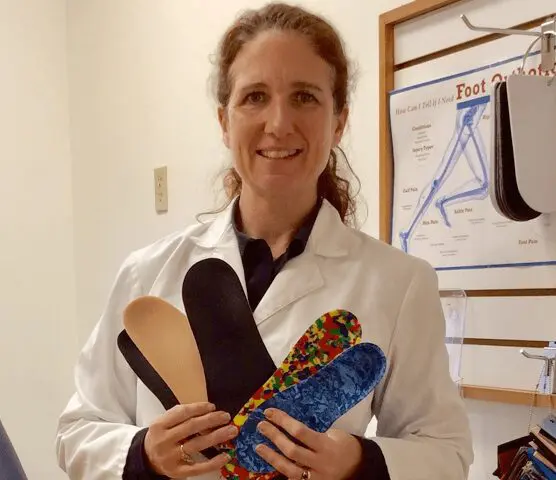Custom Made Orthotics
-
What Are Orthotics?
Orthotics are custom-made corrective shoe inserts for your feet. Orthotics improve foot movement by controlling the way your feet move.
Orthotics protect feet from wear and tear that occurs with over use or constant use in an incorrect position. They also help align the rest of your body and correct hip, knee and back positions caused by improper foot movements -
How does an Orthotic work?
An orthotic device works by controlling the way the foot works. During walking, an orthotic aligns the ankle and foot to maintain the arch of your foot, preventing flattening. By controlling foot movements, the strain on muscles, ligaments, bones, and joints is decreased. This lessens and eliminates pain in the foot and decreases transferred pain related in the knees, hip and back.
-
How are our Othotics made?
After a biomechanical assessment and gait analysis are performed to determine how the feet function and what needs to be corrected, a plaster cast is done to achieve the best mold of the the foot and arch.
We use an accredited lab to manufacture the custom orthotics. All orthotics can be adjusted in our onsite modification lab.
Frequently Asked Questions about Orthotics
-
When Do I Need An Orthotic?
Orthotics are necessary when: pain is caused by improper foot movements, if there is increased stress demands on the foot, or if foot deformities are present. Orthotics can be worn as prevention with foot deformities, if not corrected properly bunions, heel pain, flat feet, arthritis, calluses and unusual walking patterns can develop.
Orthotics can help with:
Heel pain, arch pain, calluses, corns, flat feet, high arches, toe problems/ cramps, knee, hip and lower back pain. -
Who Should I get my Orthotics from?
Chiropodists and podiatrists are the only health professionals who are exclusively trained to assess and treat foot problems. Early detection of many foot problems can prevent more serious complications from developing.
A Chiropodist will provide a complete examination of your foot. For a custom orthotics the chiropodist will carefully assess your feet through a biomechanical Assessment and Gait Analysis. A plaster cast will be taken of your feet, capturing the uncompensated foot, and creating a custom orthotic that will provide optimal control of the foot during all activities.
Chiropodists are Primary Care providers for orthotics.
-
What Is Involved In Getting Orthotics?
If you think orthotics are necessary for your condition either as prevention or to cure a discomfort, you should see a Chiropodist for a thorough foot assessment. A Chiropodist will take a medical history and perform a foot examination while you sit, stand and walk. A diagnosis will then be made. If orthotics are required, the best type will be prescribed using the appropriate corrections. There are different types of orthotics, ranging from rigid to soft. The rigid devices have the most corrective control and the soft devices provide palliative cushion to protect from weight-bearing stress during walking.
An exact mold of the bottom of your foot will then be taken using a plaster cast in the corrected position of the foot. The cast is then sent to an orthotic lab to manufacture the orthotic devices according to the Chiropodist’s prescription and specifications detailing the correction required. The orthotics will then be fitted into the patient’s shoes. Minor adjustment can be done in office in our mini lab. The patient will then be instructed on a break-in period and what to expect as the foot adjusts.
-
What Can I Expect From My New Orthotics?
It takes a small adjustment period for the foot to adapt to the correction, the orthotics are providing. Once they are comfortable with everyday use, they can be used for sports activities. Orthotic management does not end at the fitting. Footwear advice is given and review appointments are encouraged. The original complaint will be assessed at one month, six months, and a year. Additional therapies may also be recommended. Symptoms take time to develop and therefore take time to heal. The foot has to be retrained to work correctly. Children need to be monitored on a regular basis for changes in walking patterns and outgrowth of the orthotic devices.
Shoe Recommendations

Download our guide to buying shoes for adults, children and athletes of all ages.



